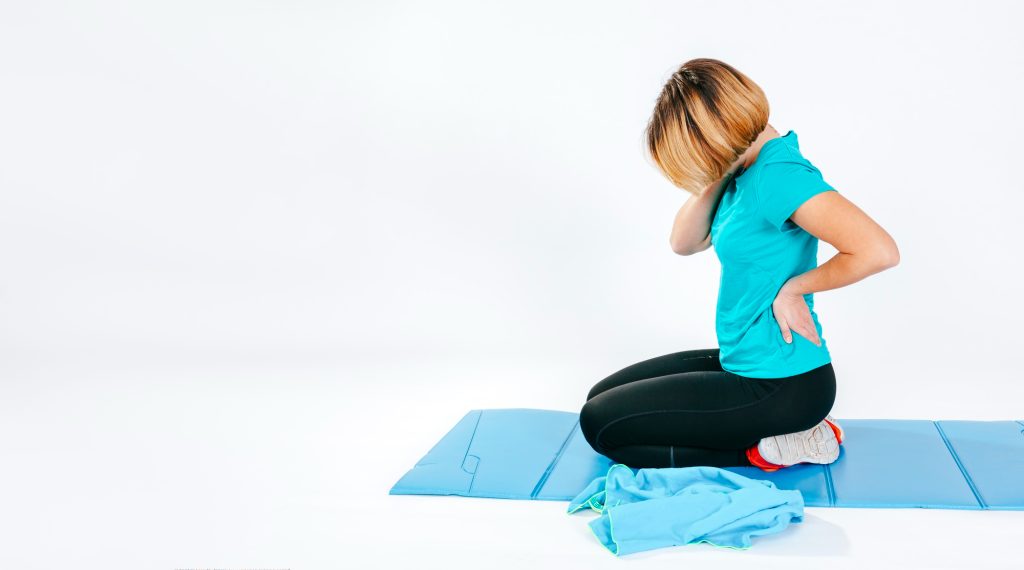Learn effective techniques to support your pelvis and alleviate girdle pain.
How to Support Your Pelvis to Reduce Girdle Pain
If you’ve ever experienced pelvic girdle pain, you know just how debilitating it can be. Whether it’s due to pregnancy, injury, or other factors, finding ways to support your pelvis can make a world of difference. In this article, we’ll explore different methods to reduce girdle pain and regain control of your life!

Understanding Pelvic Girdle Pain
Before we dive into the solutions, let’s gain a deeper understanding of what pelvic girdle pain is all about. The pelvic region is a complex structure made up of bones, muscles, and ligaments. It acts as a connector between your upper and lower body, supporting movement and stability.
To address girdle pain effectively, it’s important to grasp the anatomy of the pelvis. This intricate network of bones includes the hip bones, sacrum, and coccyx. Understanding how these components work together can help you navigate the path to relief.
Now, you may wonder what causes pelvic girdle pain in the first place. While there can be various triggers, the most common culprits include pregnancy, trauma, overuse, and hormonal imbalances. Let’s explore these factors in more detail.
The Anatomy of the Pelvis
Imagine your pelvis as a sturdy bridge connecting your upper and lower body. Made up of several bones, the pelvis acts as a strong foundation for overall body stability.
At its core, the pelvis comprises the hip bones, which connect to your legs, and the sacrum and coccyx, nestled at the base of your spine. Each element plays a crucial role in supporting your body during movement and posture.
Having a solid grasp of your pelvis’s structure will help you better understand the challenges you may face when it comes to girdle pain. So, let’s take a closer look at the common causes of this discomfort.
Common Causes of Pelvic Girdle Pain
When it comes to pelvic girdle pain, a variety of factors can come into play. One prominent cause is pregnancy. As your body changes to accommodate your growing baby, the joints and ligaments in your pelvis can become stressed, leading to pain or discomfort.
In addition to pregnancy, traumatic injuries can also contribute to girdle pain. Falls, accidents, or sports-related incidents can all impact the stability and alignment of your pelvis, causing discomfort that can last well beyond the initial injury.
Overuse is another common trigger for pelvic girdle pain. If you participate in activities that strain the pelvis, such as repetitive motions or heavy lifting, the muscles and ligaments can become overworked, leading to pain and inflammation.
Last but not least, hormonal imbalances can play a role in girdle pain. Changes in hormone levels during pregnancy or menopause can affect the ligaments that support the pelvis, making them more susceptible to discomfort.
By identifying the underlying causes, you can take proactive steps towards managing and reducing girdle pain. In the next section, we’ll explore the symptoms and diagnosis process, so you know what signs to look out for.
Symptoms and Diagnosis of Pelvic Girdle Pain
Recognizing the symptoms of pelvic girdle pain is crucial for getting the right treatment. Common signs include pain in the lower back, hips, groin, and buttocks. You may also experience difficulty walking, climbing stairs, or getting in and out of chairs.
Consulting a healthcare professional is essential for a proper diagnosis. They will conduct a thorough examination, review your medical history, and may order imaging tests. Through this process, they can identify the root cause of your girdle pain, ensuring you receive appropriate care.
Now that we understand the complexities of pelvic girdle pain, let’s explore the importance of pelvic support and its positive impact on your daily life.
The Importance of Pelvic Support
When it comes to managing pelvic girdle pain, providing adequate support to the pelvis is crucial. Proper support can alleviate discomfort, improve mobility, and enhance overall quality of life.
One way to achieve pelvic support is through the use of specialized belts or braces. These devices are designed to stabilize the pelvis, reducing strain on the joints and ligaments. They can be particularly beneficial for pregnant individuals or those recovering from pelvic injuries.
In addition to external support, exercises that target the muscles surrounding the pelvis can also help strengthen the area and alleviate pain. Physical therapists often prescribe specific exercises to improve pelvic stability and promote proper alignment.
Furthermore, maintaining good posture can significantly contribute to pelvic support. Sitting and standing with proper alignment can reduce stress on the pelvis and minimize the risk of developing or exacerbating girdle pain.
It’s important to note that the level of support needed may vary depending on the individual and the severity of their girdle pain. Consulting with a healthcare professional or a pelvic health specialist can help determine the most appropriate support options for your specific needs.
By prioritizing pelvic support, you can take an active role in managing your girdle pain and improving your overall well-being. In the next section, we’ll explore various treatment options that can provide relief and promote healing.
The Importance of Pelvic Support
Supporting your pelvis is not just about finding relief from girdle pain; it’s about regaining control and improving your quality of life. A stable and well-supported pelvis is essential for maintaining body stability and preventing further discomfort.
The pelvis plays a crucial role in body alignment and stability. By supporting this important structure, you can enhance your overall body mechanics and reduce the risk of future injuries or pain.
Living with pelvic girdle pain can have a significant impact on your day-to-day activities. Simple tasks like walking, sitting, or standing can become painful or challenging. That’s why finding effective support for your pelvis is crucial for achieving a pain-free life.
Now, let’s delve into non-surgical methods to support your pelvis and alleviate girdle pain, starting with physical therapy.
Physical Therapy for Pelvic Support
Physical therapy can work wonders when it comes to strengthening the muscles around your pelvis, providing the support needed for pain relief. A skilled therapist will design a personalized exercise program targeting your specific needs, helping you regain stability and flexibility.
Physical therapy isn’t just about exercises; it may also involve manual therapy techniques like massage and joint mobilization. These interventions can help reduce pain, improve range of motion, and enhance overall pelvic health.
Pain Management Techniques
Alongside physical therapy, there are various pain management techniques that can provide relief from girdle pain. Heat therapy, such as warm baths or heating pads, can help soothe sore muscles and relax the surrounding tissues.
Alternatively, cold therapy, using ice packs or cold compresses, can reduce inflammation and numb painful areas. Combining heat and cold therapy can create a powerful combination for pain relief.
Furthermore, techniques like acupuncture and transcutaneous electrical nerve stimulation (TENS) can also be beneficial in managing girdle pain. These approaches help stimulate the body’s natural healing mechanisms and provide relief without invasive procedures.
Lifestyle Changes for Pelvic Health
Supporting your pelvis also involves making positive lifestyle changes. Maintaining a healthy weight can help alleviate strain on the pelvis, reducing the risk of girdle pain. Regular exercise that incorporates strengthening and stretching can promote pelvic stability and flexibility.
In addition to exercise, paying attention to your posture is crucial. Practicing good posture habits, both while sitting and standing, can distribute pressure evenly throughout your pelvis, avoiding unnecessary strain.
Lastly, nutrition also plays a role in pelvic health. Consuming a well-balanced diet rich in anti-inflammatory foods, such as fruits, vegetables, and omega-3 fatty acids, can support overall pelvic health and reduce inflammation.
While non-surgical methods are effective for many individuals, some cases may require surgical intervention. Let’s explore when surgery becomes necessary and the different types of surgical options available.
Surgical Interventions for Pelvic Girdle Pain
When is Surgery Necessary?
In cases where conservative treatments fail to provide adequate relief, surgery may be necessary. Your healthcare provider will carefully evaluate your condition and consider surgical options if they believe it is the best course of action.
Surgery may be considered when there is a significant structural issue with your pelvis, such as a fracture or a joint deformity. In such cases, surgical intervention can help restore stability and alleviate girdle pain.
Types of Surgery for Pelvic Support
There are different types of surgical procedures available to address pelvic girdle pain. One common procedure is pelvic fusion, where the bones of the pelvis are joined together to provide stability.
Another option is pelvic stabilization surgery, which aims to repair damaged ligaments or structures in the pelvis, restoring stability and reducing pain.
It’s important to note that surgical interventions are typically reserved for severe cases where non-surgical methods have been exhausted. Your healthcare provider will guide you through the decision-making process, ensuring you have all the information you need to make an informed choice.
Preventive Measures to Avoid Pelvic Girdle Pain
Regular Exercise and Pelvic Health
An ounce of prevention is worth a pound of cure. Regular exercise that focuses on pelvic stability and strengthening can help prevent girdle pain from occurring in the first place.
Exercises like pelvic floor exercises, yoga, and Pilates can promote core strength and stability, reducing the risk of girdle pain. Engaging in low-impact exercises, such as swimming or cycling, can also be beneficial for overall pelvic health.

Importance of Good Posture
Posture is not just about looking confident; it’s about maintaining proper alignment and reducing strain on your body. Practicing good posture habits, such as sitting up straight and avoiding slouching, can have a positive impact on your pelvic health.
Avoiding excessive sitting, especially in positions that place strain on the pelvis, is crucial. Take frequent breaks, stretch, and switch positions regularly to prevent girdle pain from creeping in.
Nutritional Support for Pelvic Health
The saying “you are what you eat” holds true when it comes to pelvic health as well. Consuming a balanced diet can support the health of your pelvis and reduce the risk of inflammation and pain.
Incorporate foods rich in vitamins, minerals, and antioxidants, such as fruits, vegetables, whole grains, and lean proteins. Hydrate adequately and limit the consumption of processed foods, refined sugars, and saturated fats.
By adopting these preventive measures, you can actively reduce the chances of experiencing pelvic girdle pain and maintain optimal pelvic health.
In Conclusion
Pelvic girdle pain can be a significant obstacle, impacting your day-to-day life and overall well-being. However, through various means of support, both non-surgical and surgical, and taking preventive measures, it is possible to find relief and regain control over your pelvic health.
Remember, understanding the anatomy of the pelvis, recognizing common causes and symptoms of girdle pain, and seeking appropriate diagnosis and treatment are key steps in your journey towards living a pain-free life.
So, don’t let pelvic girdle pain hold you back. Take charge today, explore the options at your disposal, and embrace the support you need to bring comfort back to your pelvis!



